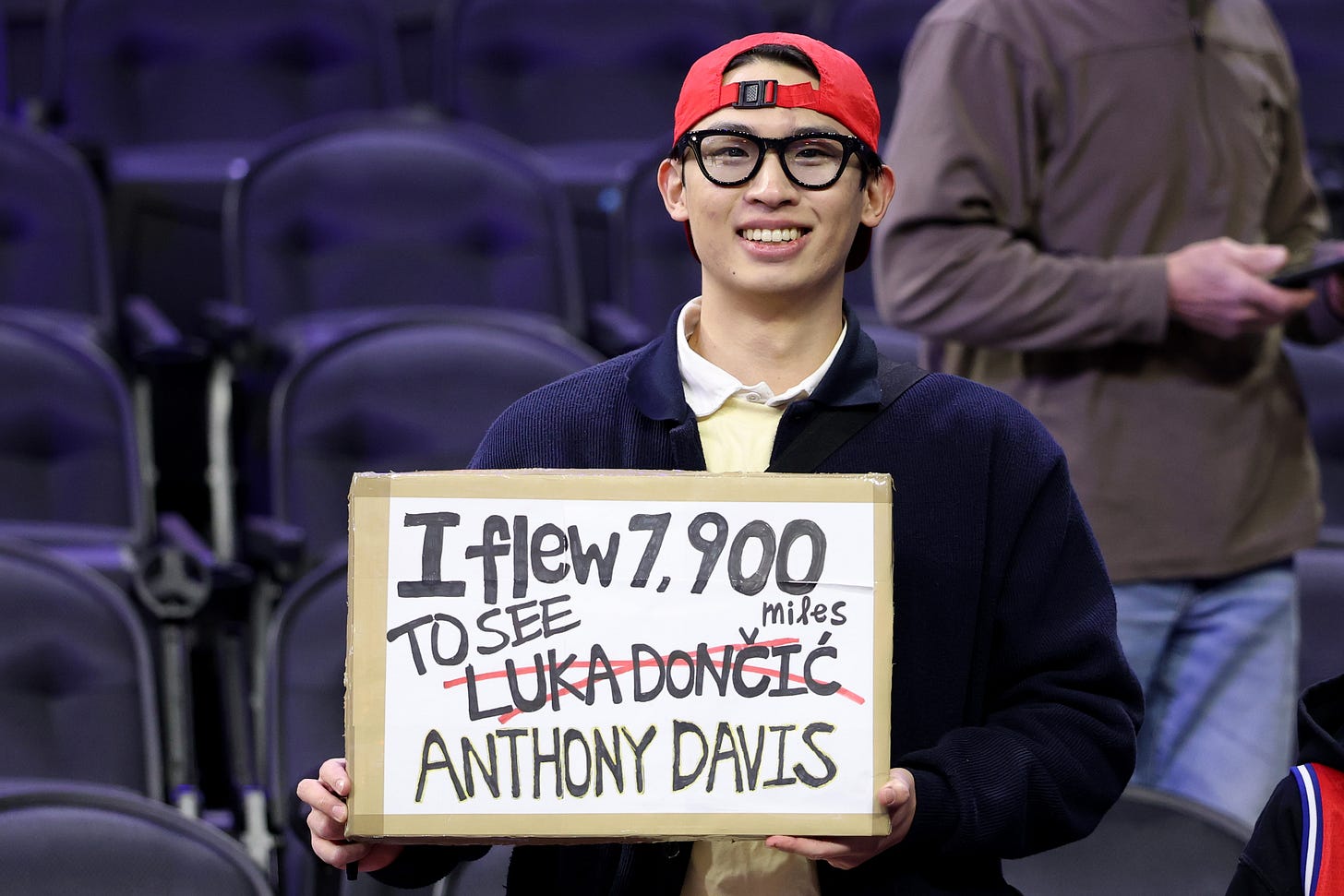Seeing Double: What Lakers and Mavs Games Against Shared Opponents Reveal
New observations from Lakers and Mavs games—including early AD takeaways
The Luka Dončić trade didn’t just shake up the NBA and the Mavericks fanbase—it also flipped my content plans upside down.
I had to pivot mid-season, moving away from detailed game-by-game Mavericks coverage and shifting toward bigger picture trends and storylines to make sense of such a seismic change.
That doesn’t mean I stopped watching. Far from it. If anything, it meant double the homework as I tried to keep up with both the post-Luka Mavs and the newly formed Lakers. And at least early on, with the Mavs injury-riddled and spiraling, it was rarely double the fun. But lately, with Dallas getting healthier, Anthony Davis making his anticipated return, and Dereck Lively II and Daniel Gafford possibly returning this week, watching both teams has offered something new: perspective.
Especially during recent Eastern Conference road trips, when both teams faced the same opponents, sometimes even in back-to-back games. To be fair, March basketball with a weird schedule (in the Lakers’ case that unfortunately meant an incredibly difficult stretch of 10 games in 15 days with four back-to-backs) and plenty of teams tanking is not the best time for in-depth takeaways. So, it’s kind of hard to say if the Mavericks beating the Nets, Magic, and Bulls—the same teams the Lakers lost to recently—says more about the Lakers or about the current, more healthy state of the Mavericks.
Like it or not, swapping superstars as different as Dončić and Davis not only linked the two franchises for a long time, it also forced both teams into a radical in-season stylistic makeover. And watching that happen on the fly from both angles has been fun and interesting to follow.
Today’s highlights:
The most important thing in basketball…isn’t the basketball 📈
Two different models, two ongoing transformations – Part I
Two different models, two ongoing transformations – Part II
Transition defense and another side effect of the Dončić–Davis swap 📊
1-The most important thing in basketball…isn’t the basketball 📈
Any time Charles Barkley talks, you know controversy’s not far behind. During a recent March Madness studio segment, The Round Mound of Rebound gave the kids a lesson, saying the most important stats in basketball are rebounds and turnovers—and that the most important thing in basketball is, simply, the basketball.
This prompted a response from the O.G. of basketball analytics, Dean Oliver, a person whose concepts and analytical models I deeply respect and often rely on in my own work, as he stepped in like a true teacher to correct Sir Charles and offer the kids a better lesson.
Why am I sharing this exchange here? Because I think there are two real lessons in it.
The first: the ongoing rise in three-point shooting is increasing game-to-game variability, making outcomes more dependent than ever on whether those threes are falling. It means you might see one team shoot the lights out and upset a good opponent one night, only to fall apart the very next day.
Shooting luck can be a major factor—though not the only one—behind the streaks teams go through. During the Lakers’ recent eight-game winning streak, their opponents shot just 31% from three, the worst mark in the league over that span. Since then, many of those same types of shots have started falling, with opponents hitting 39% from deep.
The Magic, statistically the worst three-point shooting team in the league, hit 38 percent from deep in their win over the Lakers. A couple of nights later, they shot only 17 percent in a loss to the Mavericks. Similarly, the Nets, another poor outside shooting team, went 40 percent from three in their win against the Lakers, then dropped to 33 percent in a loss to Dallas.
Shot-making from three is not the only thing that decides basketball games. Barkley is right that rebounds, turnovers, fouling, and other factors matter too. But three-point shooting is becoming increasingly important because of one key reason: volume. And that brings me to my next point.
2-Two different models, two ongoing transformations – Part I
If you’ve ever listened to Celtics head coach Joe Mazzulla, it’s not hard to figure out which corner he’s in.
‘Red Auerbach said it best. Rebounding is the second most important thing. The first is shooting.’ - Joe Mazzulla
The Celtics lead the NBA in three-point attempt rate at 50.2 percent and are on track to become the first team in league history to take more than half of their shots from beyond the arc. The 3-versus-2 math was one of the issues—not the only one—the Mavericks faced in the Finals. Only a third of their shots came from three, compared to the Celtics' 47 percent three-point frequency. After the Finals, Nico Harrison highlighted shooting as the key priority and backed up his words by acquiring Klay Thompson and Quentin Grimes, two high-volume three-point shooters. Increasing the Mavericks' three-point volume was the first thing I wrote about on this platform, and it was the main reason I believed they had a real shot at becoming a top-five offense this season.
We know what happened next, and the shift away from that plan and strategy is just one of many baffling parts of the trade.
Keep reading with a 7-day free trial
Subscribe to digginbasketball to keep reading this post and get 7 days of free access to the full post archives.







